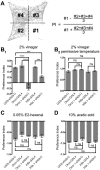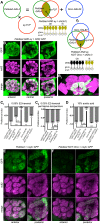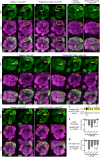Extremely sparse olfactory inputs are sufficient to mediate innate aversion in Drosophila
- PMID: 25927233
- PMCID: PMC4416024
- DOI: 10.1371/journal.pone.0125986
Extremely sparse olfactory inputs are sufficient to mediate innate aversion in Drosophila
Abstract
Innate attraction and aversion to odorants are observed throughout the animal kingdom, but how olfactory circuits encode such valences is not well understood, despite extensive anatomical and functional knowledge. In Drosophila melanogaster, ~50 types of olfactory receptor neurons (ORNs) each express a unique receptor gene, and relay information to a cognate type of projection neurons (PNs). To examine the extent to which the population activity of ORNs is required for olfactory behavior, we developed a genetic strategy to block all ORN outputs, and then to restore output in specific types. Unlike attraction, aversion was unaffected by simultaneous silencing of many ORNs, and even single ORN types previously shown to convey neutral valence sufficed to mediate aversion. Thus, aversion may rely on specific activity patterns in individual ORNs rather than the number or identity of activated ORNs. ORN activity is relayed into the brain by downstream circuits, with excitatory PNs (ePN) representing a major output. We found that silencing the majority of ePNs did not affect aversion, even when ePNs directly downstream of single restored ORN types were silenced. Our data demonstrate the robustness of olfactory aversion, and suggest that its circuit mechanism is qualitatively different from attraction.
Conflict of interest statement
Figures





Similar articles
-
Olfactory processing and behavior downstream from highly selective receptor neurons.Nat Neurosci. 2007 May;10(5):623-30. doi: 10.1038/nn1881. Epub 2007 Apr 8. Nat Neurosci. 2007. PMID: 17417635 Free PMC article.
-
Differential Contributions of Olfactory Receptor Neurons in a Drosophila Olfactory Circuit.eNeuro. 2016 Jul 28;3(4):ENEURO.0045-16.2016. doi: 10.1523/ENEURO.0045-16.2016. eCollection 2016 Jul-Aug. eNeuro. 2016. PMID: 27570823 Free PMC article.
-
Excitatory local circuits and their implications for olfactory processing in the fly antennal lobe.Cell. 2007 Feb 9;128(3):601-12. doi: 10.1016/j.cell.2006.12.034. Cell. 2007. PMID: 17289577 Free PMC article.
-
Development of olfactory projection neuron dendrites that contribute to wiring specificity of the Drosophila olfactory circuit.Genes Genet Syst. 2014;89(1):17-26. doi: 10.1266/ggs.89.17. Genes Genet Syst. 2014. PMID: 24817758 Review.
-
Elements of olfactory reception in adult Drosophila melanogaster.Anat Rec (Hoboken). 2013 Sep;296(9):1477-88. doi: 10.1002/ar.22747. Epub 2013 Jul 31. Anat Rec (Hoboken). 2013. PMID: 23904114 Review.
Cited by
-
Most primary olfactory neurons have individually neutral effects on behavior.Elife. 2022 Jan 19;11:e71238. doi: 10.7554/eLife.71238. Elife. 2022. PMID: 35044905 Free PMC article.
-
Identification of multiple odorant receptors essential for pyrethrum repellency in Drosophila melanogaster.PLoS Genet. 2021 Jul 8;17(7):e1009677. doi: 10.1371/journal.pgen.1009677. eCollection 2021 Jul. PLoS Genet. 2021. PMID: 34237075 Free PMC article.
-
A GAL80 Collection To Inhibit GAL4 Transgenes in Drosophila Olfactory Sensory Neurons.G3 (Bethesda). 2018 Nov 6;8(11):3661-3668. doi: 10.1534/g3.118.200569. G3 (Bethesda). 2018. PMID: 30262521 Free PMC article.
-
The conserved IR75 subfamily mediates carboxylic acid detection in insects of public health and agricultural importance.J Insect Sci. 2025 Jan 20;25(1):10. doi: 10.1093/jisesa/ieaf012. J Insect Sci. 2025. PMID: 39891408 Free PMC article. Review.
-
Primacy coding facilitates effective odor discrimination when receptor sensitivities are tuned.PLoS Comput Biol. 2019 Jul 19;15(7):e1007188. doi: 10.1371/journal.pcbi.1007188. eCollection 2019 Jul. PLoS Comput Biol. 2019. PMID: 31323033 Free PMC article.
References
Publication types
MeSH terms
Substances
Grants and funding
LinkOut - more resources
Full Text Sources
Other Literature Sources
Molecular Biology Databases

